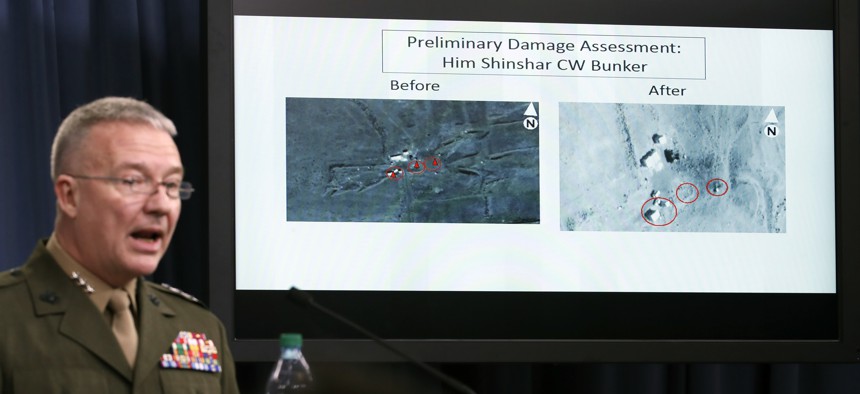
Marine Lt. Gen. Kenneth F. McKenzie Jr., director, Joint Staff, speaks as he shows photographs from before and after the U.S.-led airstrikes against Syria during a media availability at the Pentagon on April 14, 2018. AP / Alex Brandon
Pentagon Declares Strike Successful. Here’s A Look at What Went Into It
U.S., French, and British planes and ships used a wide variety of precision weapons to hit Syrian chemical weapons facilities. Some saw their first day of combat.
Saturday’s U.S.-French-British strike “overwhelmed” the Syrian air defenses and degraded the Assad regime’s chemical weapons capabilities, Pentagon leaders told reporters this morning. Three facilities were targeted in the 4 a.m. strike, in which allied warships and -planes fired 105 weapons, including the first combat use of the Joint Air to Surface Standoff Missile, or JASSM, Lt. Gen. Kenneth McKenzie, Jr. said.
McKenzie said the Syrians responded by firing 40 surface-to-air missiles, most of them after the allied munitions had already struck their targets. The head of the joint staff called the defensive fire “materially ineffective” against the coalition forces, but said it likely did pose a threat to civilians on the ground. “It is likely that the regime shot many of these missiles on a ballistic trajectory – without guidance,” he said. “When you shoot iron in to the sky without guidance, it will inevitably fall to earth.”
The most significant target was the Barzah Research and Development Center, located close to downtown Damascus, and heavily protected by Syrian air defenses. It was targeted by U.S. warships, which launched 57 Tomahawk cruise missiles and B-1 bombers 19 JASSM missiles. The bombers were escorted by attack aircraft and an EA-6B electronic warfare jet. McKenzie said initial assessments indicated the Barzah center was destroyed. “This Is going to set the Syrian chemical weapons [program] back years” he said. (Story continues below.)

Before-and-after DigitalGlobe satellite images of the Barzah Research and Development Center (Damascus, Syria) that was struck by U.S. and coalition operations on the morning of April 14, 2018. The image on the right, taken April 15, was collected by Digital Globe’s WorldView-3 satellite at approximately 10:45 AM local time. The image on the left was taken on April 13 by WorldView-2. Photo courtesy DigitalGlobe, a Maxar company
The second site was the Hims-Shinshar Chemical Weapons storage facility near Homs, against which U.S. forces fired nine Tomahawks. The British fired eight Storm Shadow cruise missiles from Royal Air Force Tornado jets.
France also participated in the strike, sending Rafale and Mirage combat jets and the Languedoc FREMM multipurpose frigate. French forces fired three Naval Cruise Missiles and two SCALP land cruise missiles at the Hims-Shinshar Chemical Weapons facility and another seven SCALP missiles at the final target, the Hims-Shinsahar Chemical Weapons Bunker. Pentagon officials said both targets appear to have been destroyed.
The JASSM and the French-made Storm Shadow allow non-stealth jets to attack targets beyond the range of air defenses, 500 miles in the case of the JASSM. The cruise missiles themselves are “low observable,” making it difficult for air defenses to see and track.
Russian officials had earlier vowed to shoot any missiles out of the sky, a threat they did not follow through on. “We do not have any indication that any Russia air defense systems were employed,” said McKenzie.
Largely absent from the firefight was the dreaded Russian S-400 anti-aircraft radar and missiles, the later of which have a range of more than 250 km. The presence of the weapon had been a concern for the U.S. forces, and likely accounted for the use of the EA-6B electronic warfare jet.
“The Russians have used Syria to operationally test their systems and see how they operate. If you look back over time and look at the different strikes that they’ve done, they’ve gone and used Syria as an opportunity to see how well their systems are working. From a cyber and electronic attack perspective, we watch that stuff.” Lt. Gen. Jeffrey Harrigan said at an Air Force event in September.
When asked how the S-400 affected his choice to use certain planes over others, Harrigan said, “‘Those capabilities were part of the equation that I have to think through... We are consistently monitoring them to see if something changes their intent because we have to manage that and respond quickly… We look at it everyday. It’s an every day discussion to make sure our force can manage that risk.”
McKenzie did not say whether or not the S-400 radars were turned off on Saturday morning, only that its batteries did not fire on the attacking jets. Asked whether Russian or Syrian forces used electronic warfare or cyber measures against coalition forces, McKenzie answered only, “The Syrian response was remarkably ineffective in all domains. That’s the best answer I can give you.”
Marcus Weisgerber contributed to this report.





